Spillage Prevention and Airflow-Pattern Monitoring for High-Shear Process Operations
The author proposes techniques, based on Six Sigma methods, for monitoring such processes to discover their airflow patterns and reduce opportunities for spillage.This article is part of PharmTech's supplement "Solid Dosage and Excipients 2010."
This article is part of PharmTech's supplement "Solid Dosage and Excipients 2010."
One of the major challenges in the process industries is to monitor and measure the spillage in manufacturing operations. This challenge arises particularly during operations that involve high-shear mixing. An operation is difficult to maintain if it handles micrometer-sized particles (< 100 µm). Monitoring the spillage and leaks in such dust-forming operations is crucial for ensuring safety and prevents process losses. Particles emitted from a unit operation also can present a risk of cross contamination in a biopharmaceutical and pharmaceutical processing plant. Detailed study of equipment design during the process startup can increase process efficiency, ensure the environmental neutrality and safety of the operation, and prevent cross contamination. Manufacturers can use ultraviolet (UV) light to monitor the particles that are not observable in visible light, and UV light already has been used in applications such as forensics, safety assurance, astronomy, sterilization, pest control, water and air purification, chemical markers, and photochemotherapy (see Figure 1).
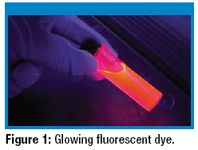
Figure 1
Six-Sigma approach
Companies can implement the Six-Sigma philosophy and the define, measure, analyze, improve, and control (DMAIC) model to monitor and measure spillage (see Figure 2). As IBM noted, "A goal without a plan is a wish," but the Six-Sigma philosophy helps operators plan experiments methodically (1).
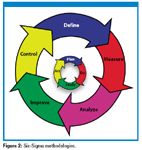
Figure 2
Define
The most crucial phase of the project is the definition, which should be clear and concise and reflect the contributions of all relevant cross-functional groups. The criteria for measuring success for a high-shear mixer must be clear. The goal of processing biopharmaceutical active ingredients is to achieve 100% recovery or eliminate spillage. To achieve this goal, operators must conduct a detailed examination of all of the mixer's major points of connection. Most leakage occurs from gaskets, fittings, and the upper opening of a hopper. Knowing and taking note of these critical points for examination is especially important. When conducting this kind of study, one should always be ready for surprises that result from variations between individuals' perceptions. The author used an IKA Labor Pilot -2000/4 MHD Module (IKA, Wilmington, NC) to mix a solid-liquid-phase dispersion at Genzyme's (Cambridge, MA) Ridgefield, New Jersey, facility (2). This unit comprises an ultrafine spaced rotor-stator assembly.
Measure
In the measuring phase of the study, one should use the tools appropriate to the nature of the operation. This article describes the following three techniques to aid the measurement of spillage: using UV light to observe the flow pattern and leakage points, using settling plates to observe particle decomposition, and using an air particle counter to measure spillage.
UV light. Micrometer-sized particles (< 100 µm), which cannot be observed in daylight by the human eye, can be seen easily under UV light. The electromagnetic spectrum of UV light can be subdivided into several segments. UV light A (UVA), also called black light, has a wavelength range of 400 to 315 nm. The energy per photon is 3.10 to 3.94 eV.
The International Organization for Standardization's draft standard for determining solar irradiances (i.e., DIS-21348) states that although black lights produce light in the UV range, their spectrum is confined to the long-wave UVA region (see Figure 3). Unlike UVB and UVC, which are responsible for the direct DNA damage that leads to skin cancer, black light is limited to low-energy long waves and does not cause sunburn. However, UVA can damage collagen fibers and destroy vitamin A in skin (3). Operators should take precautions to avoid direct exposure while using UV light.
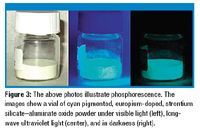
Figure 3
A pseudostudy can be performed by using UV-fluorescent material such as the copolymer of melamine. Vitamin A and the B vitamins thiamine, niacin, and riboflavin are strongly fluorescent. A solution made of vinegar and a crushed vitamin B-12 tablet glows bright yellow under a black light. Melamine copolymer is water insoluble and can be detected under UV light easily because it glows bright violet. The material should be used as a placebo, and the operation should be performed as usual. After the UV light is turned on, the flow of the material can be observed once the mixing operation starts. Operators should record this process with a camera so that it can be analyzed later. The operation and the critical points of spillage can be pinpointed and recorded easily. The spillage can be caused by the operator's technique or by the equipment.
Settling plates.Smooth, stainless-steel coupons can be used as settling plates and placed dry, wet with water, or wet with an adhesive on previously identified critical points. After placing the plates, the mixing operation should be run as normal with a fluorescent agent for a certain amount of time. In an operation that results in much spillage, a time of 5 min normally is sufficient, but operations that result in light spilling can require hours or days. After the operation is finished, the plates should be analyzed under UV light. Comparing the plates side by side helps operators identify the critical points easily (see Figures 4 and 5).
Air particle counter.The above techniques can be performed with an air particle counter probe. The probe can be placed on the critical points while the operation is running. This placement enables operators to measure the number of particles in the air sample at a particular point. Any air particle counter with a laser-diffraction beam can perform this study. The numbers can be recorded and analyzed using a statistical software such as JMP (SAS, Cary, NC). Safety departments in the industry normally use the particle counter to measure permissible exposure limits. Air particle counting can be done with a mass flow 100 particle counter (model A2408 laser particle counter, Met One Instruments, Grants Pass, OR).
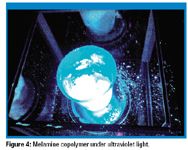
Figure 4
Analyze
This phase examines the data gained during the previous experiments. Operators can perform the analysis for the first experiment (i.e., monitoring the process under UV light) through close viewing of the recorded video. If personnel modify the mixing process later, they can evaluate the improvements afterward using the same method. The video sometimes reveals minor details that went unnoticed during the operation. The analysis of the second experiment (i.e., settling plates) can be performed either by observing the plates under a microscope or, if the appropriate material was used, by a technique such as high-performance liquid chromatography, gas chromatography, or ultrahigh-performance liquid chromatography for assay. In the latter case, the plates should be rinsed thoroughly with a solvent, and samples should be prepared carefully. The third experiment (i.e., the particle counter) generates data directly, and operators can analyze the digital recording on the counter.
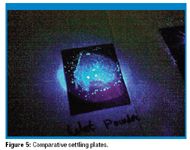
Figure 5
Improve
When the flaws in the process have been identified, the method for improving the process should be chosen. One method of improving the process is to train the operators to improve their material-handling techniques. Operators can watch the video and review the analysis data generated during the previous phase. Clear visual perception of the material is critical when handling an active ingredient or hazardous chemical that cannot be seen with the naked eye. The operators should have proper safety equipment while they perform critical processes.
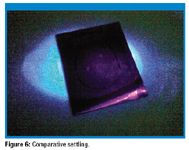
Figure 6
An alternative is to improve the equipment design to reduce or eliminate spillage. Most often, a cross-functional team with representatives from the equipment vendor is useful in developing conceptual designs. Once the design is complete, it can be tested with simulation software from companies such as COMSOL (Stockholm) and AspenTech (Cambridge, MA), which will reveal flaws. The airflow monitoring pattern developed during video analysis can be a helpful tool for simulation development (4, 5).
Controls
The final stage after implementation of the changes is to monitor the operation continuously for improvement. Minor improvement is always possible. If possible, process changes should be recorded in the company's continuous-improvement program, which will enable the effectiveness of the changes to be evaluated quarterly or semiannually.
Conclusion
Spillage and dusting is a major challenge in the biopharmaceutical industry when an operation involves micrometer-sized particles. Through continuous improvement and techniques such as Six Sigma, the challenges can be associated with critical process points. This approach enables personnel to pinpoint the problem and provide direction for solutions. The DMAIC model provides an excellent directional approach for solving these problems.
Piyush Viradia is a process engineer at Genzyme, 1125 Pleasant View Tr., Ridgefield, NJ 07663, tel. 201.993.1577, piyush.viradia@genzyme.com.
References
1. IBM, "Aligning Lean Six Sigma in Managing Process Development," white paper (IBM, Armonk, NY, August 2002).
2. IKA, Labor Pilot2000/4 mill, MHD module specifications, www.ikausa.com/labmixersinline.htm, accessed Apr. 7, 2010.
3. Space Environment Technologies, "ISO 21348 Process for Determining Solar Irradiances Compliance," www.spacewx.com/ISO_solar_standard.html, accessed Apr. 7, 2010.
4. P. Jeffries, Chem. Eng. J. 24 (2), 36-41 (2005).
5. A. Agrawal, Chem. Eng. J. 24 (2), 42-49 (2005).
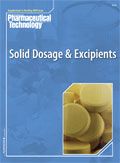
Drug Solutions Podcast: A Closer Look at mRNA in Oncology and Vaccines
April 30th 2024In this episode fo the Drug Solutions Podcast, etherna’s vice-president of Technology and Innovation, Stefaan De Koker, discusses the merits and challenges of using mRNA as the foundation for therapeutics in oncology as well as for vaccines.